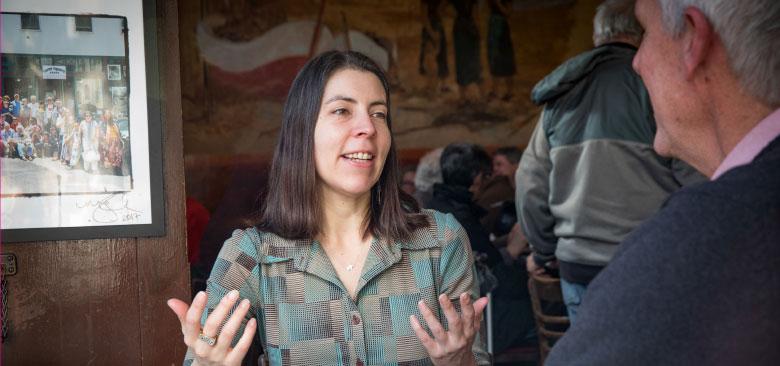
Stacy Torres enjoys coffee with an older friend in a North Beach cafe in San Francisco (photos by Elisabeth Fall).
Understanding the Irreplaceable Role of Mom-and-Pop Spaces for Aging Adults: A Conversation with Stacy Torres
Ethnographer Stacy Torres, assistant professor at the UC San Francisco School of Nursing, is shedding a unique light on how we think about social ties and social relationships among older people – how places affect social interactions, particularly in areas where gentrification is changing the character of neighborhoods. In addition to publishing in academic journals and mainstream periodicals, including the New York Times and San Francisco Chronicle, Torres is also working on a book examining social relationships among older people experiencing aging-related changes.
She grew up in Manhattan’s Chelsea neighborhood, the daughter of an immigrant from Chile, and was the first in her family to go to college. Some of her research was inspired by what she observed in the mom-and-pop places that have long served as informal community gathering spots for neighborhood elders, but that are increasingly threatened by gentrification in urban areas like New York and San Francisco.
We recently spoke with Torres about the genesis of her work, what she’s discovered and what she hopes to achieve. The interview has been edited for length and clarity.
How did you come to sociology?
I fell into sociology through one of my general education courses when I was in college at Fordham University in Manhattan. I was a comparative literature major, but my adviser, Jeanne Flavin, was a sociology professor, and she took me under her wing, and I ended up taking a lot of sociology classes. It was very important for me, as the first person in my family to go to college, to have somebody who was excited about a topic and saw something in me that I didn’t.
I had to figure out if sociology was something I was interested in or if I was just enamored of this professor, but over time, I came to understand and appreciate how sociology helped me make sense of my own life and of some of the things I observed around me and my family.
My mother passed away when I was just a teenager, so things were difficult, which runs contrary to this happy American narrative where everybody is like you and if you put in the effort, you’re supposed to just shoot up to the top of the social ladder. Studying sociology helped me to feel like it wasn’t just me, that I was part of larger historical and social trends, that it wasn’t just about blaming someone for being poor or having difficulty in their family.
So that’s where it started, and from there, I was able to branch out to larger things that I was concerned about that were beyond my personal experience.
How did that lead to a research career?
Jeanne gave me a window into what it was like to be a professor. At the time, I thought my options were business school or being a doctor or a lawyer. I thought I wanted to be a lawyer – I was very social justice oriented – but I did an internship in a Bronx family court one summer, and I decided afterwards that law was not for me.
I got to know Jeanne, and she had what looked to me like a cool life. She taught, which I really wanted to do, and she worked at a university. She told me a little about the process of writing research articles.
I went into my PhD program at New York University a little naive, as many people do, really focused on the idea that I wanted to teach at a university. Over time, I learned that research is a big part of the whole endeavor, and I fell in love with it.
Prior to entering the PhD program, I completed an MFA in creative nonfiction writing at Columbia University, and I saw creative writing and qualitative research as complementary. Since then, I’ve been trying to figure out how to marry the two approaches to understand social life.
What led you to study neighborhood gathering places and older adults?
My dissertation focused on older adults in New York City and how they are dealing with a two-pronged set of challenges. First, how do they manage daily life and the crises that come up when you’re over age 60. For example, how do you deal with health problems when you’ve lost your partner or your children have moved away? And then, second, there are the challenges that occur in the context of New York City and the changing neighborhood demographics and gentrification. If you’ve lived in the neighborhood for several decades, or for your entire life, and it’s suddenly very different in character and very expensive, how do you deal with that?
The study started in a little bakery I’d been going to that had been there since 1962. Everybody else there was decades older than me – in their late 60s to their 90s. And I started to think about what the place meant to these people and how it formed their routines.
When I found out that the bakery only had about six months left on its lease and the owner wasn’t going to be able to renew it, the question that emerged was, what’s going to happen now to all these people? What are their relationships, and how does it all figure into their larger social lives?
Did you reach any conclusions?
I’m still writing them up now, in several articles and for the book with the University of California Press. One interesting thing was to observe what happened with people as they had to find alternate locations. It was challenging for them because they were never able to exactly re-create the conditions they found in the little bakery, which had become a de facto senior center for people who didn’t want to go to senior centers. It was important for them to get out of the house and have some social contact, but they didn’t want to be in a space that was set aside just for people over 65.
That was an important finding because I think it’s going to be more and more a feature of the later parts of the life course, especially with the baby boom cohort that don’t identify with the older generation and often have different family compositions, and who want more choice in their spaces.
 “Like millennials, a lot of older adults want to live in urban environments that are public transit rich, where you can walk to places,” says Torres. Another of the study’s important contributions that’s become clearer is that, like millennials, a lot of older adults want to live in urban environments that are public transit rich, where you can walk to places. It’s very expensive [to live in such cities], and gentrification is happening not just in the big coastal cities, but across the country. We don’t know much about the experience of older adults in gentrifying areas, so this study has provided insight into that experience. Even among study subjects that had secure housing in rent-controlled apartments or affordable housing, there was a feeling of displacement due to commercial gentrification, and it took its toll. You get attached to places and people, and it only takes a few small establishments in your neighborhood closing, and your whole routine could be turned upside down.
“Like millennials, a lot of older adults want to live in urban environments that are public transit rich, where you can walk to places,” says Torres. Another of the study’s important contributions that’s become clearer is that, like millennials, a lot of older adults want to live in urban environments that are public transit rich, where you can walk to places. It’s very expensive [to live in such cities], and gentrification is happening not just in the big coastal cities, but across the country. We don’t know much about the experience of older adults in gentrifying areas, so this study has provided insight into that experience. Even among study subjects that had secure housing in rent-controlled apartments or affordable housing, there was a feeling of displacement due to commercial gentrification, and it took its toll. You get attached to places and people, and it only takes a few small establishments in your neighborhood closing, and your whole routine could be turned upside down.
I discovered that the relationships created in these places were much more complex than I had thought. Even though I was observing a lot of things that people who study social networks by conventional measures would say indicate that people are really close – they confide in each other and help each other when problems come up – when I talked to them, they would not list these neighborhood connections as the most important people in their lives, even though they were spending several hours a day or a week with them. I found that a lot of them were hesitant to say, “This is my friend; we’re so close.”
That was fascinating. I think my study offers important insights into these ambiguous but very important relationships and how they develop and are sustained. If you just surveyed them about their relationships, you might not pick up on these other connections that turn out to be important. I call them “elastic ties.”
That seems analogous to the relationships millennials form within online communities. We sometimes don’t think these relationships are real and important, but they are.
I think there are a lot of comparisons. We have different points in our lives, like moving to a new city or another big transition like a divorce or retirement, where we have to create a new network. The question is, who are these people in our lives? What do we call them?
There have been a couple of studies looking at people who have become very close quickly – they have accelerated intimacy. Matthew Desmond, who wrote the book Evicted, had a paper on disposable ties, where he found that people who had been newly evicted could suddenly be very close with someone they met at a bus stop. They might end up sharing an apartment or helping each other, but they didn’t have much information about each other.
What I found with my group was sort of the inverse: They could be very close, but there was always an effort to keep some distance. Sometimes it was conscious, and sometimes it was less conscious. People might spend a lot of time together for years and not have each other’s addresses or phone numbers or last names. Sometimes they didn’t even have each other’s first names.
Where are you in your work, and what impact do you hope it will have?
I’m wrapping up a series of academic articles and a book on the study. Each paper and part of the book looks at different aspects. There’s a chapter and a paper describing these relationships. A recently published paper examines how gossip served as a form of social support. Another part looks at the features of the spaces where people spend time. I’m working on a paper with a graduate student as a co-author that looks at some of the translational implications of these informal spaces for people’s care and their caregivers.
One finding I’ve stumbled upon in the course of the study is all the dissatisfaction people had with the idea of going to a senior center. Maybe they went and had a negative experience, or they felt there was a stigma attached to certain spaces that serve older adults. They also felt there was a lot of ageism in these spaces and in medical settings – people didn’t take the time to go over information. The older adults would use the informal settings to supplement those interactions or figure out what the doctor said or what they should do with the information. They discussed it with other people to make sense of those interactions.
I would hope the book reaches a broad enough audience, not just academics. My goal is to write it in a way so that curious laypeople could engage with the material and understand it. I think about my mother, who was a voracious reader and worked as a secretary. She had only graduated high school, and I would never want to write something my mother wouldn’t be able to understand.
I do hope the book increases our understanding of what it’s like when you’re older and in a changing neighborhood environment, and how important these informal spaces are. They’re precious, but they’re threatened, especially in highly gentrified cities. If there are policy people and social service providers out there who read the book, maybe they’ll know a bit more and be able to use that information to develop better policies that improve people’s lives.



